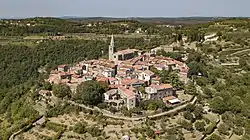Grisignana
Grožnjan (Italian: Grisignana) is a settlement and municipality in Croatia. It is part of Croatia's Istria County, which takes up most of the Istrian peninsula. 39% of the municipality's population has Italian ethnicity.
Grožnjan
Grisignana | |
|---|---|
Municipality | |
| Grožnjan Municipality Općina Grožnjan - Comune di Grisignana[1] | |
 View of Grožnjan | |
 Flag | |
| Nickname(s): The town of artists | |
 Grožnjan Location of Grožnjan in Croatia | |
| Coordinates: 45°23′N 13°43′E | |
| Country | |
| County | |
| Government | |
| • Mayor | Claudio Stocovaz |
| Area | |
| • Total | 68.42 km2 (26.42 sq mi) |
| Population (2011)[3] | |
| • Total | 736 |
| Time zone | UTC+1 (CET) |
| • Summer (DST) | UTC+2 (CEST) |
| Website | Grožnjan Municipality Official Website |
History
Early history
In Grožnjan/Grisignana are found ancient Roman artifacts and near Grožnjan/Grisignana is the remains of a Roman house, but the first mention of Grožnjan/Grisignana dates from 1102, when Margrave of Istria Ulric II and his wife Adelaida granted their land to Patriarch of Aquileia. In this document the fort is called Castrum Grisiniana. In 1238 Grožnjan/Grisignana was the property of Vicardo I Pietrapalosa. In 1286, Grožnjan fort was lent to the Aquileian patriarch during war with Venice but changed sides in 1287 and Grožnjan was given to Venice.[4]
Vicardo's son Pietro inherited Grožnjan/Grisignana after his father's death in 1329, and when he died in 1339 it again became the patriarch's property. The patriarch rented it to a Friulian noble family, de Castello. In 1354 Grožnjan's new owner became Volrich, or Ulrich, Reifenberg, who in 1358 sold it to Venice for 4,000 ducats in order to pay his debts. Volrich was a son of Deitalm, a descendant of Aquileian patriarch Volcher, and in 1356, during the war between Venice and Hungary, his army, entrenched in Grožnjan/Grisignana, strongly resisted the Hungarian army. Yet it seems that at the same time Volrich negotiated the surrendering of Grožnjan/Grisignana in Venice.
Venetian Republic
Venice took Grožnjan/Grisignana over in 1358 and ruled until its demise in 1797. In 1359 the Umag captain Pietro Dolfin moved to his new residence in Grožnjan, and in 1360 and 1367 he fortified the town walls and renovated the palace.
Captain's Office moved from Grožnjan to Raspo in 1394, when a central rule was established for the whole area. Since then Grožnjan was governed by Venetian noblemen who were given the title of "Mayor". From the early 16th century Grožnjan's mayors were chosen among Koper noblemen. In the 15th century judicial duties were performed by the Pietrapelosas, and in 1446 the town walls were fortified in order to protect it from possible Turkish attacks. After the terrible plague in 1630 the Grožnjan area became almost completely deserted. In order to revitalize the area the St. Mark's Republic brought Italian families from Veneto and Friuli; these were mostly tradesmen who settled in towns. Settlers were invited by the Republic of Venice to cultivate the abandoned land in some hamlets around Grožnjan. Most of the settlers were Morlachs from Dalmatia, but also Slavic people, Albanians and Greeks, all refugees of the Ottoman Empire.
All settlers in Istria were given free land and were exempt from fiscal duties and work obligations for twenty years; the only condition was to cultivate the land within five years. Economic success of colonization of villages reflected on the towns as well: trade and transportation developed and demographics improved.
Austrian Empire
After the fall of Napoleon's Empire in 1813, his Illyrian Provinces, including Grožnjan, became part of the Austrian Empire. In 1816 the Austrian Emperor Francis II visited Grožnjan/Grisignana on his tour through Istria and met with the local clergy and population.
During Austrian rule the Grožnjan/Grisignana area flourished. Building of the Parenzana railroad in 1902 enhanced development of trade and agriculture. Wine, olive oil, eggs and other produce were sold in Koper/Capodistria and Trieste. According to the 1910 census, the settlement of Grožnjan had 1,658, and the municipal area 4,028 inhabitants. The town had a doctor, a post office, a school, a lawyer, notary public, oil processing plant, bakery, groceries and clothing stores, two butchers, several inns and various trade shops (shoemakers, blacksmiths, tailors, carpenters, etc.).
Kingdom of Italy
The dissolution of the Austrian Empire, the subsequent Italian rule and the Great Depression had its consequences. In the 1920s people started to emigrate, looking for work in Trieste and overseas. During the rule of the Kingdom of Italy Grožnjan/Grisignana attained waterworks, the area was electrified, and the Mirna/Quieto river valley was reclaimed.
SFR Yugoslavia
After the Second World War, Istria was divided into two parts, the Yugoslav one and the Free Territory of Trieste, which was divided into Zone A, controlled by the US Army, and Zone B, controlled by the Yugoslav Army. Grožnjan/Grisignana become a part of Zone B. On October 5, 1954 the London Memorandum was signed and Zone A was assigned to Italy, and Zone B to the People's Federal Republic of Yugoslavia. In 1975 the Treaty of Osimo divided the Free Territory of Trieste and Grožnjan/Grisignana became part of Yugoslavia.
The London Memorandum provided the population with the option of emigration to Italy. The new Yugoslavia's emergent communist system and its application, along with lingering hostilities between Italians and Yugoslavs (like the murder of priest Francesco Bonifacio), contributed to a large wave of emigration (part of the Istrian exodus). By April 1956, 2/3 of the population emigrated from the area to Italy.
In 1955 Grožnjan/Grisignana lost its municipality status and became part of the municipality of Buje/Buie. In 1965, when the Town of Arts was founded, some of the housing was given to artists from Croatia, Slovenia and Vojvodina, and some were assigned to the Cultural Centre of the International Music Youth Federation in 1969. In 1993 Grožnjan/Grisignana got its municipality status again.
Demographics
According to the 2011 census, the whole of Grožnjan/Grisignana Municipality has 736 inhabitants, while the settlement of Grožnjan itself has 164 inhabitants.[3] The ethnic composition of the municipality is 39.40% Italians, 29.62% Croats, 18.21% regionally declared ("Istrians"), and 2.17% Slovenes.[5] The native language in the municipality is 56.52% Italian, 37.36% Croatian, and 2.72% Slovene.[6]
The municipality consists of following settlements:
- Antonci (Antonzi), population 62
- Bijele Zemlje (Terre Bianche), population 80
- Grožnjan (Grisignana), population 164
- Kostanjica (Castagna), population 48
- Kuberton (Cuberton), population 18
- Makovci (Macovzi), population 107
- Martinčići (Martincici), population 140
- Šterna (Sterna), population 70
- Vrnjak (Vergnacco), uninhabited
- Završje (Piemonte d'Istria), population 47
Culture
Grožnjan/Grisignana is today known as "Town of artists". It has about 20 art galleries, it hosts summer film school, and it has become international centre of Croatian music youth. Grožnjan has an annual jazz festival "Jazz is Back-BP", that was started by Boško Petrović, attracting international musicians, such as Georgie Fame in 2007, Mike Sponza. In 2008 it won the European award for best small jazz festival. It is held for two or three weeks, in the second half of July. Grožnjan/Grisignana also has an annual painting festival, the Ex Tempore, hosting more than 300 artists from whole Europe.[7]
Gallery
 Houses in Grožnjan
Houses in Grožnjan Shop in Grožnjan
Shop in Grožnjan Ballet Course in Grožnjan
Ballet Course in Grožnjan Typical alley
Typical alley Summer School
Summer School Wine Exhibition
Wine Exhibition Olives near Grožnjan
Olives near Grožnjan Loggia of Grožnjan
Loggia of Grožnjan
References
- "Statut Općine Grožnjan". Grožnjan - Grisignana. Retrieved 24 January 2020.
- "Općine na područjima posebne državne skrbi Republike Hrvatske" (PDF). Croatian Chamber of Economy. Retrieved 15 April 2020.
- "Population by Age and Sex, by Settlements, 2011 Census: Grisignana". Census of Population, Households and Dwellings 2011. Zagreb: Croatian Bureau of Statistics. December 2012.
- "History: Past Centuries". Retrieved 19 October 2020.
- "Population by Ethnicity, by Towns/Municipalities, 2011 Census: County of Istria". Census of Population, Households and Dwellings 2011. Zagreb: Croatian Bureau of Statistics. December 2012.
- "Population by Mother Tongue, by Towns/Municipalities, 2011 Census: County of Istria". Census of Population, Households and Dwellings 2011. Zagreb: Croatian Bureau of Statistics. December 2012.
- "U nedjelju u Grožnjanu kreće festival Jazz is Back!BP". Glas Istre (in Croatian). Retrieved 19 October 2015.
External links
| Wikimedia Commons has media related to Grožnjan. |
